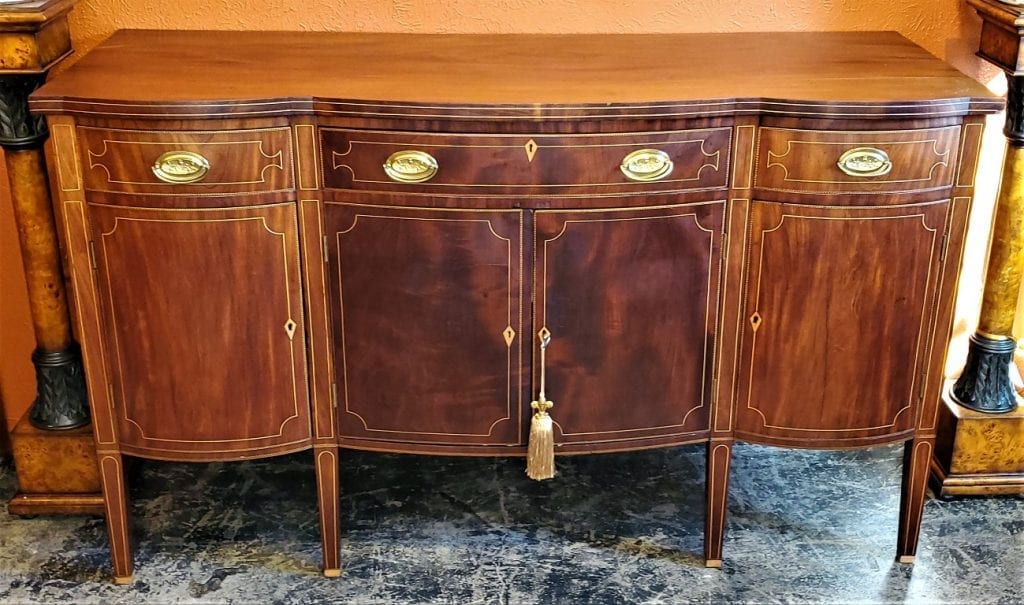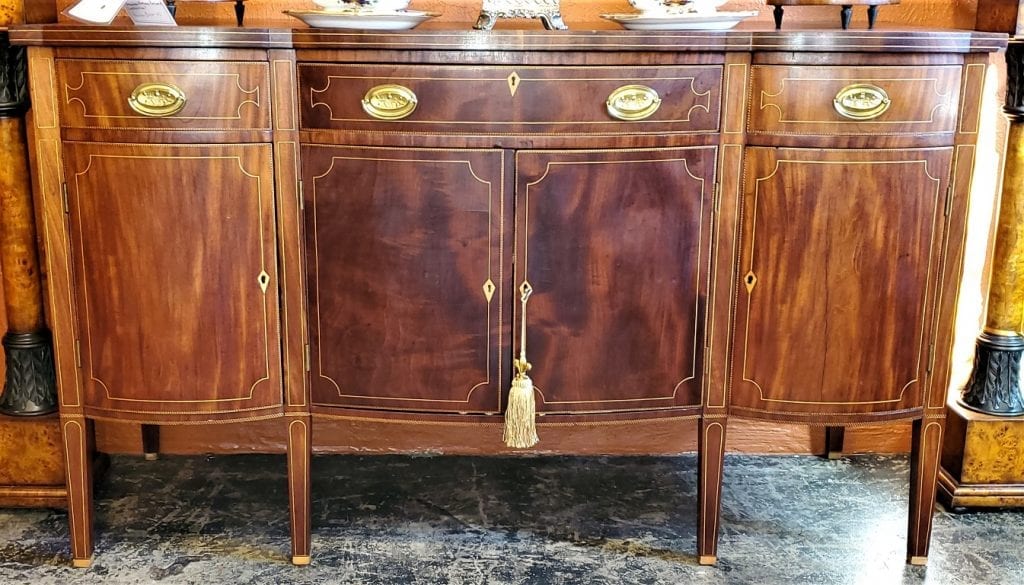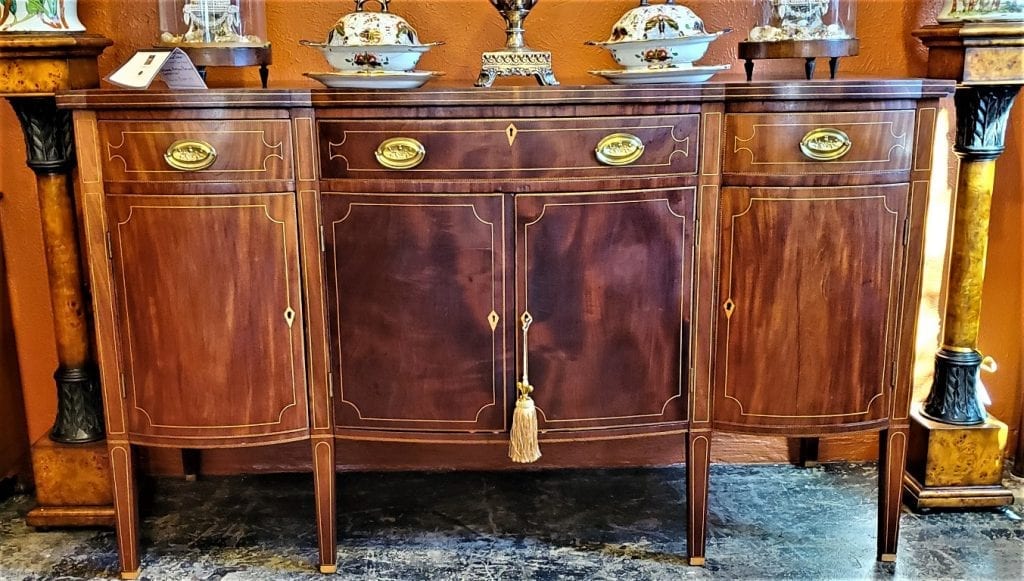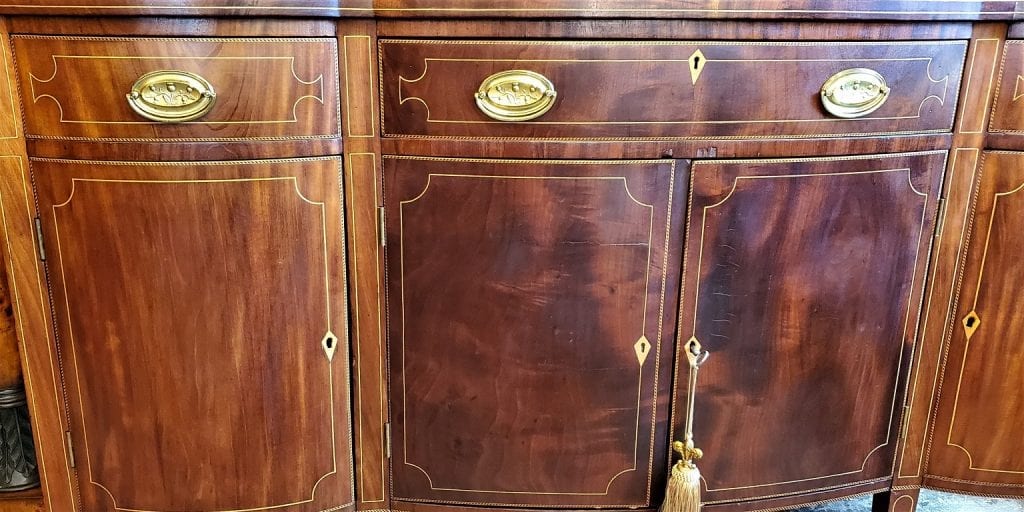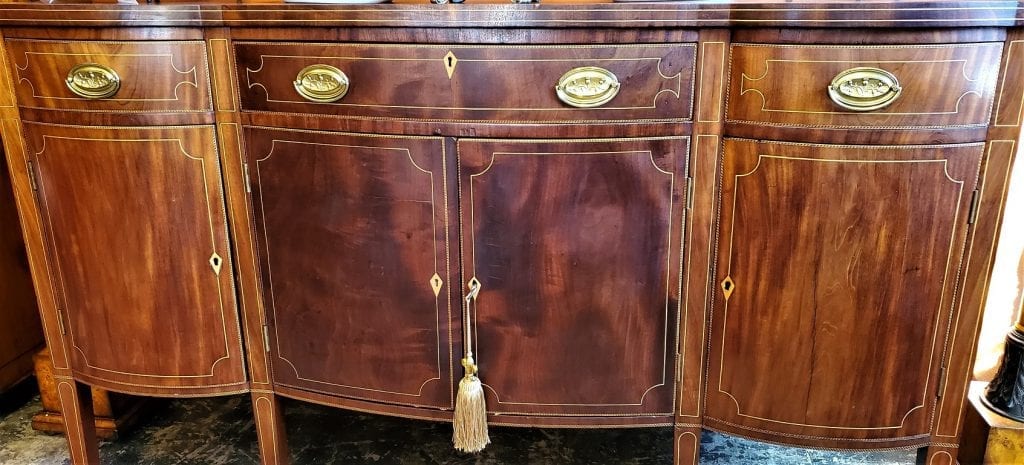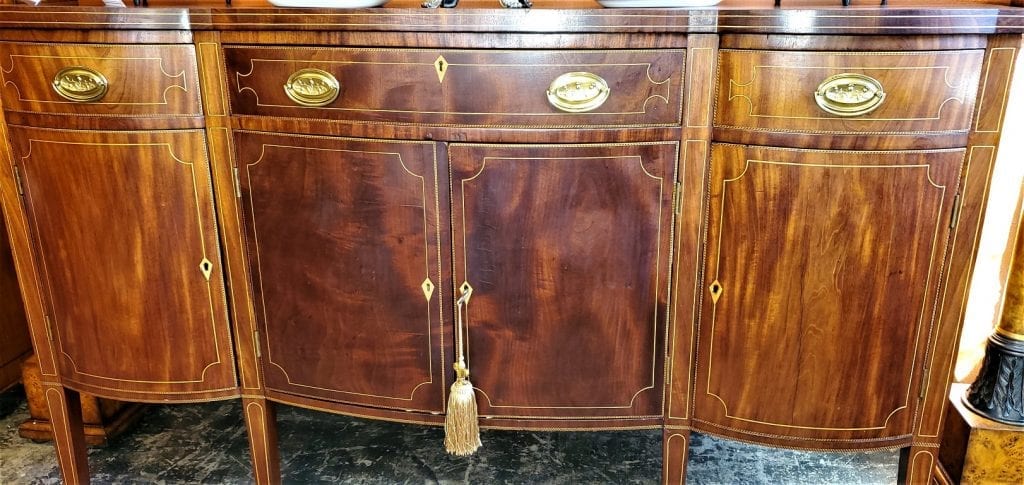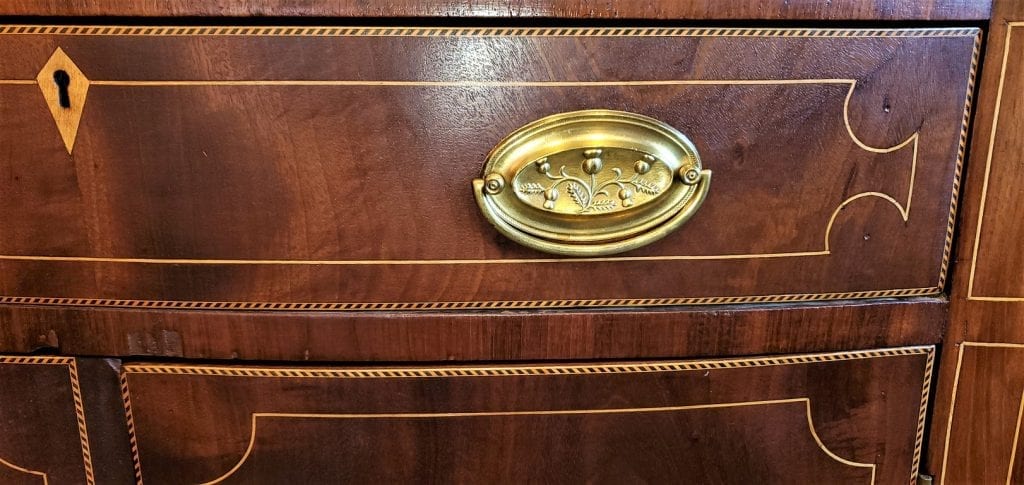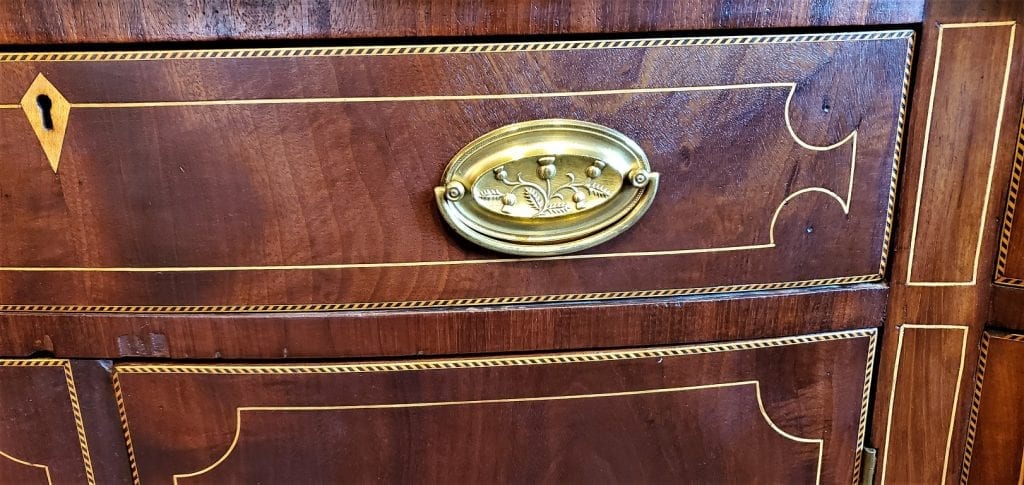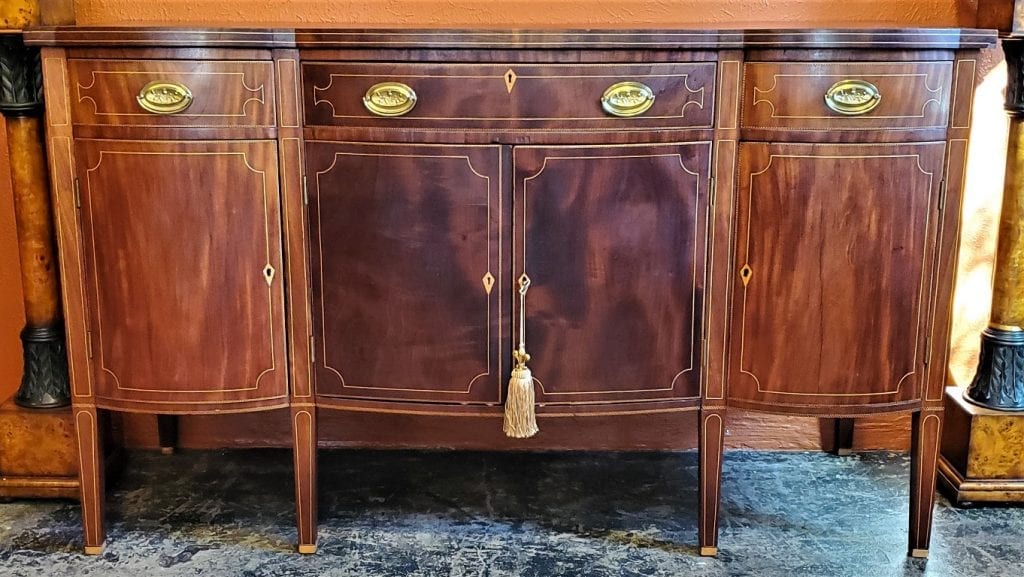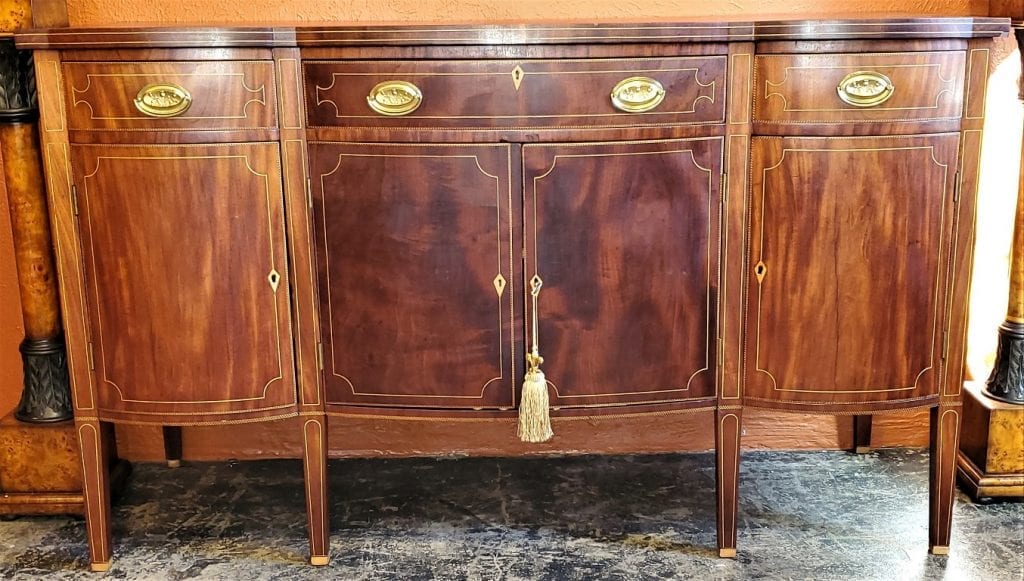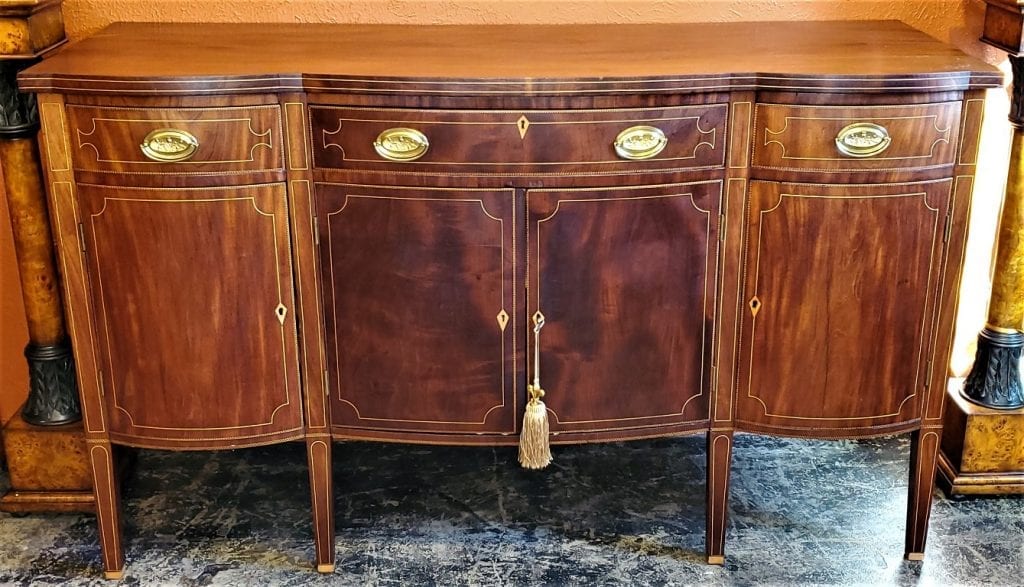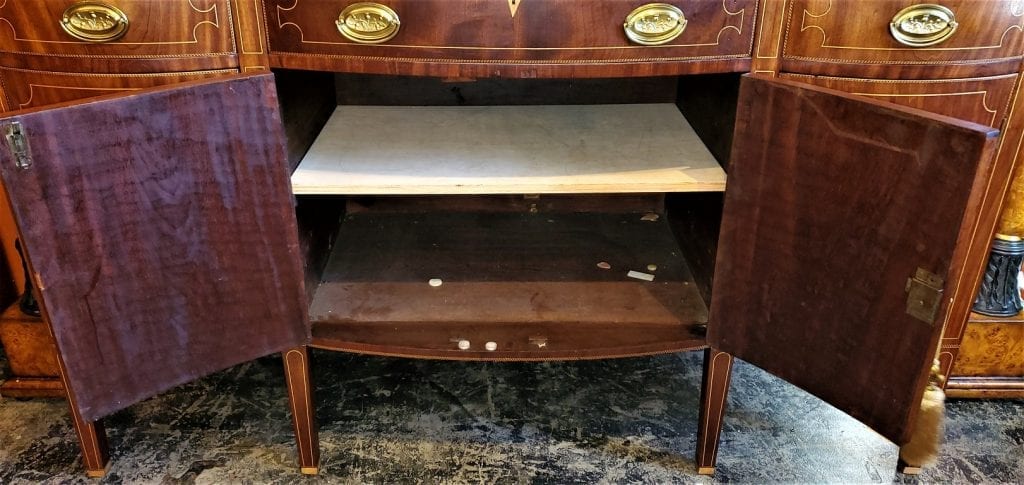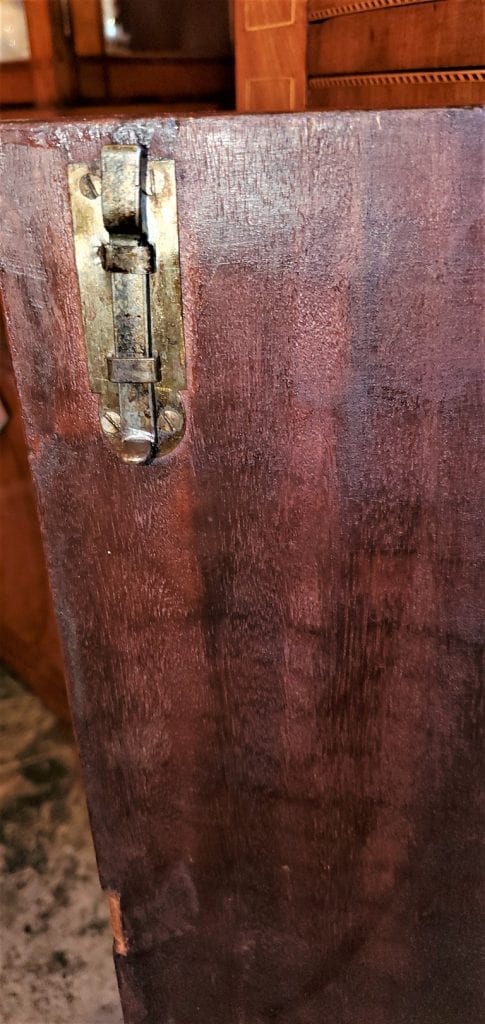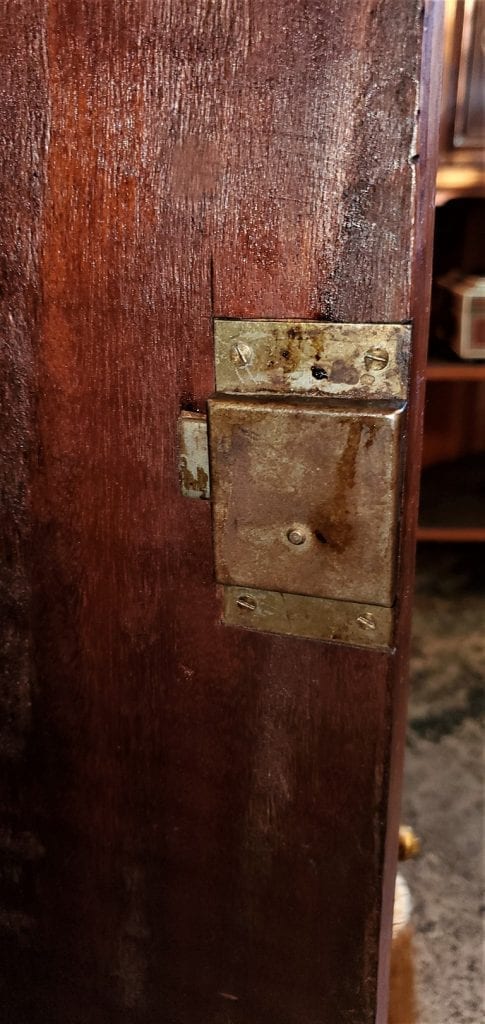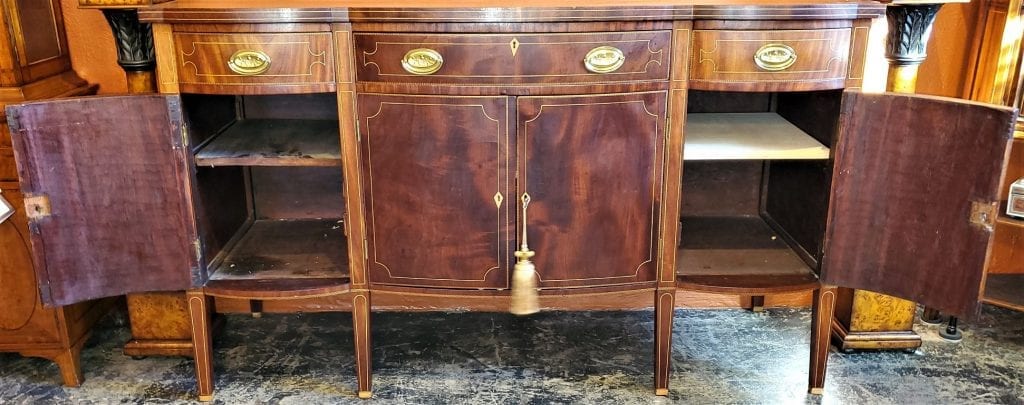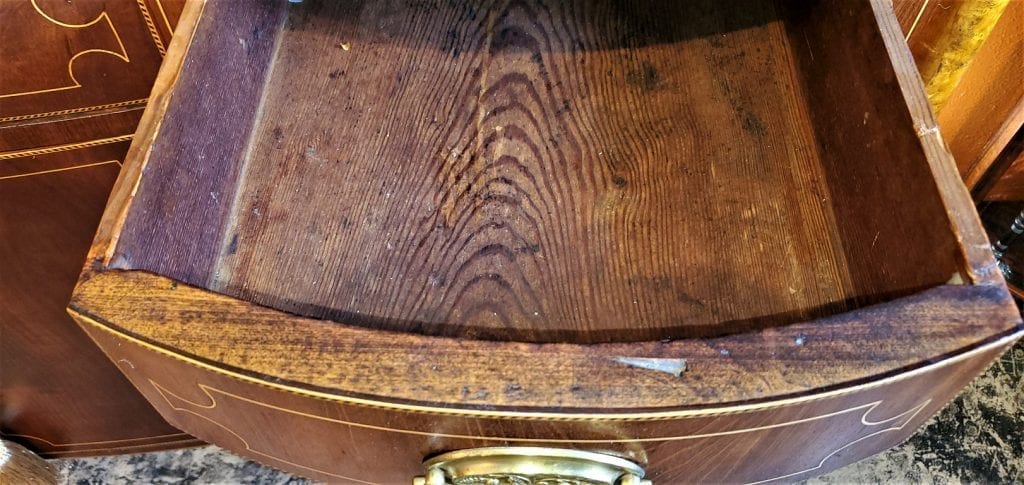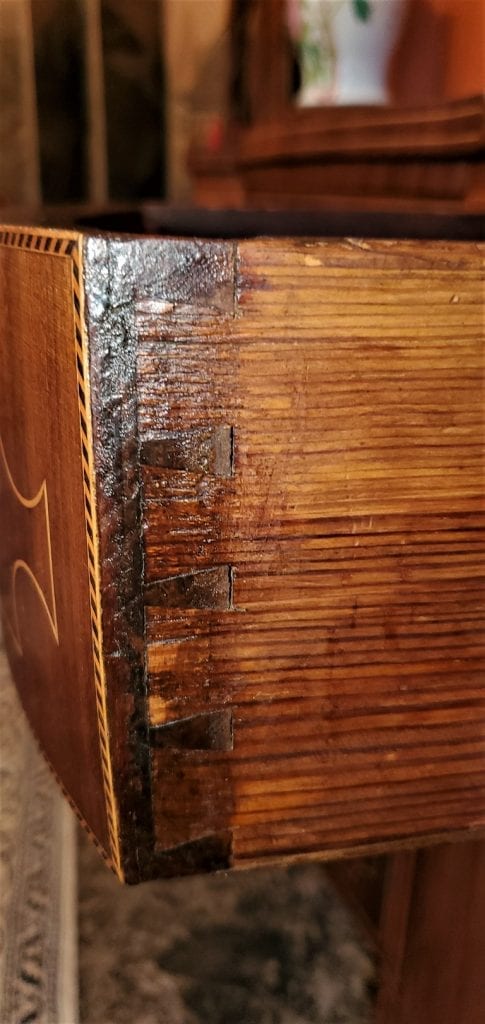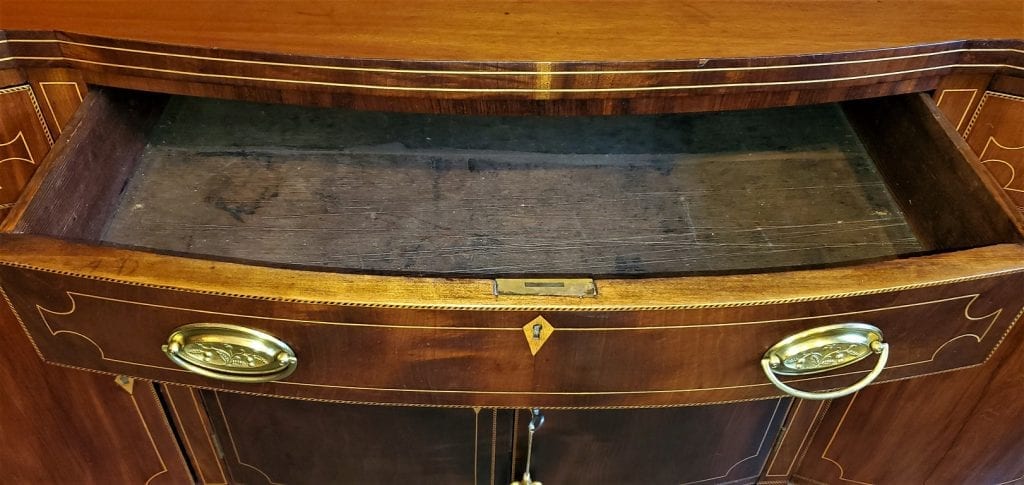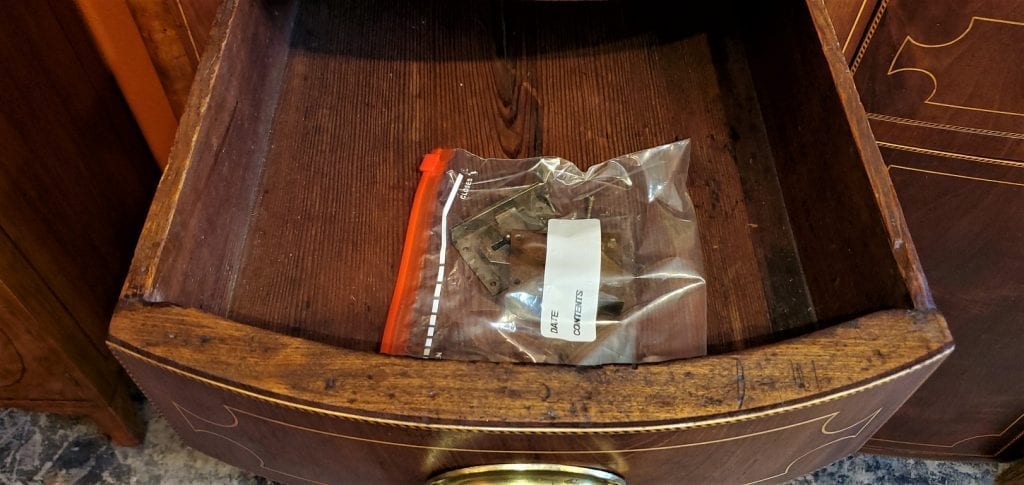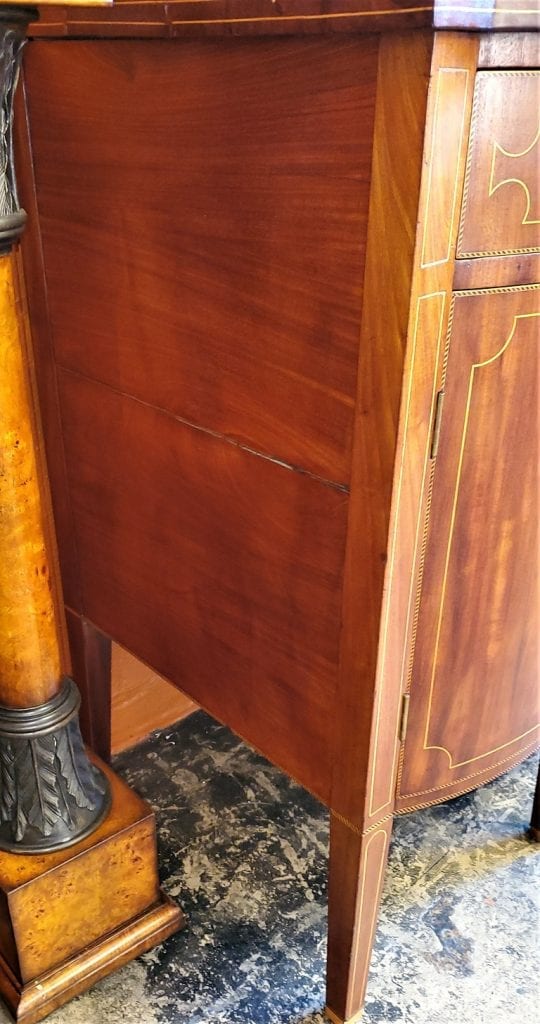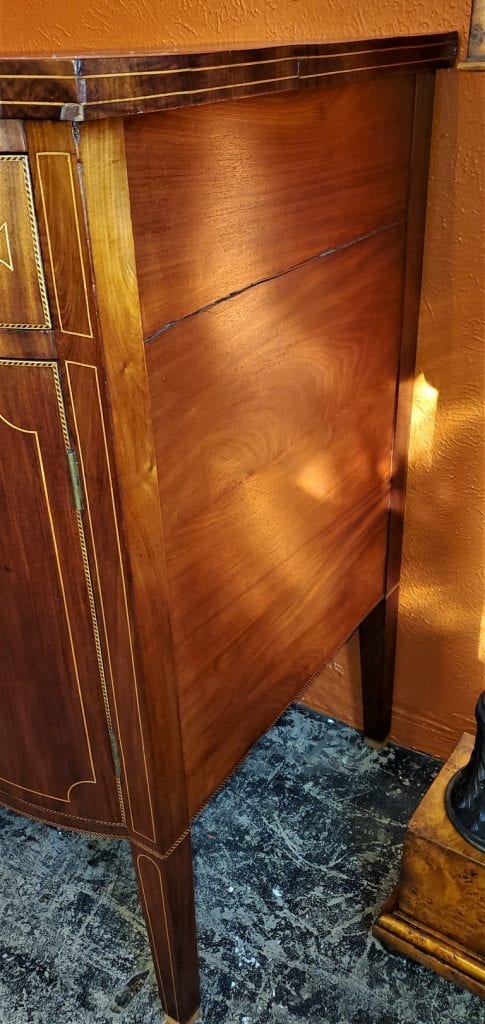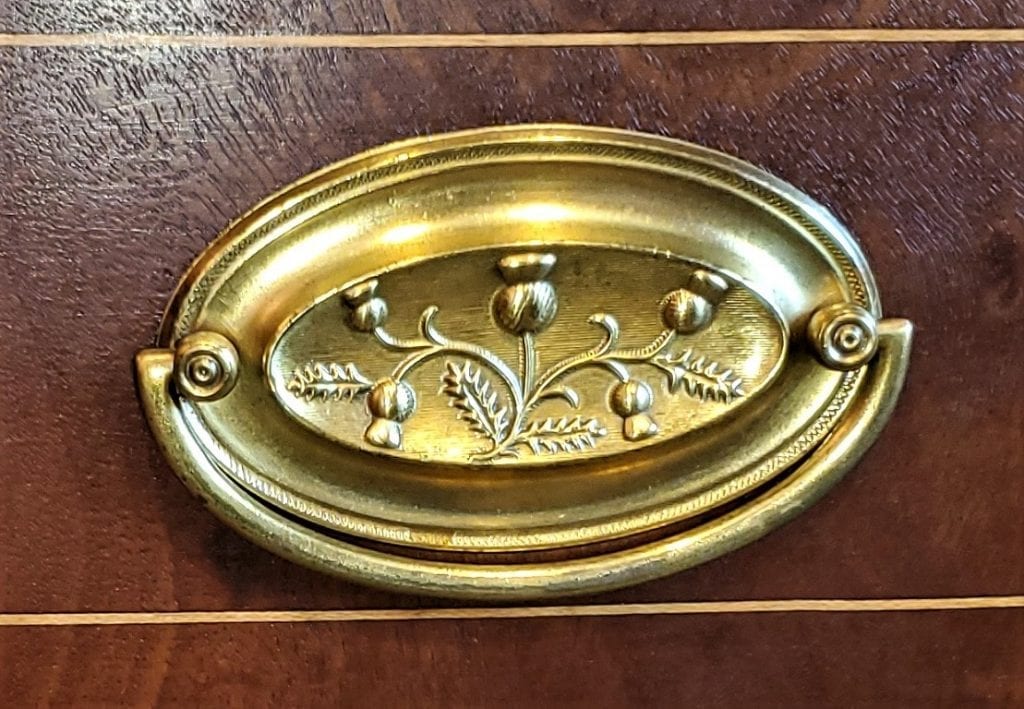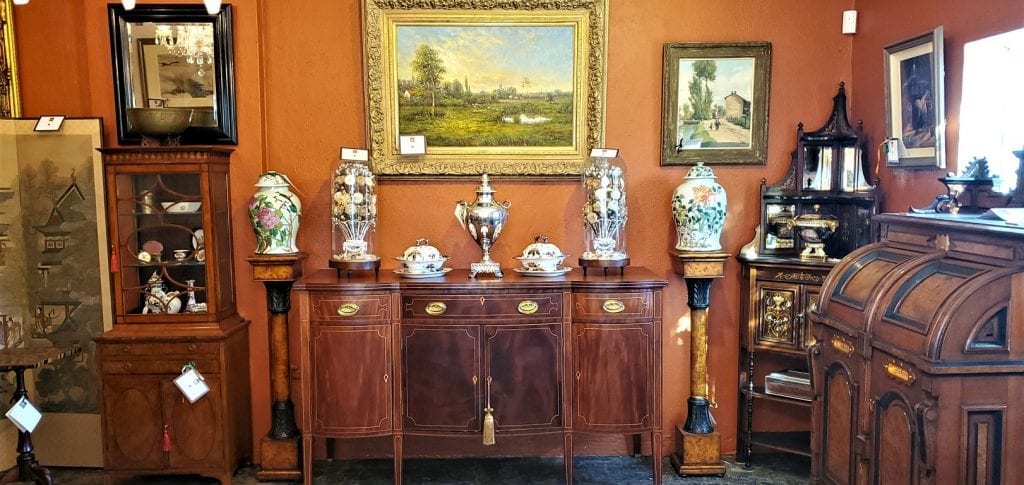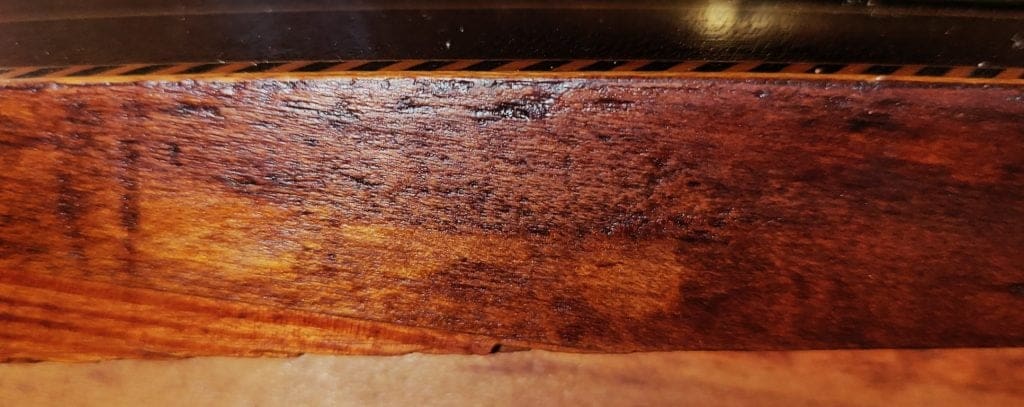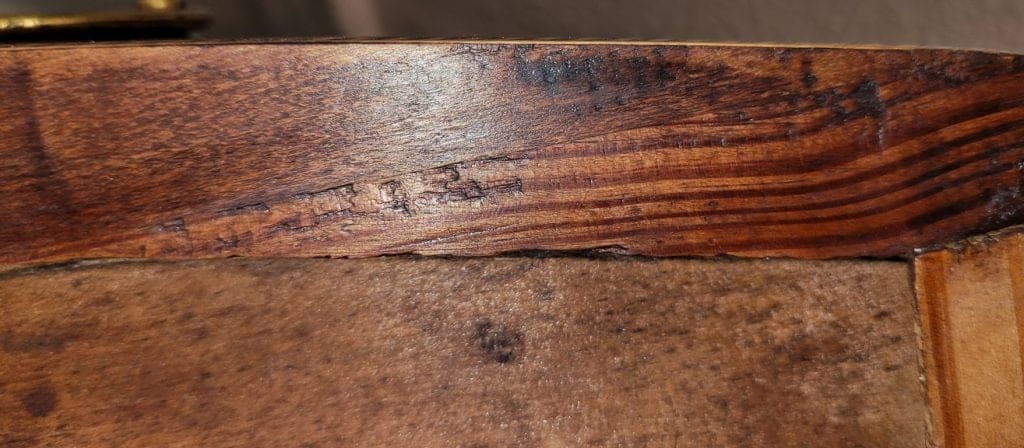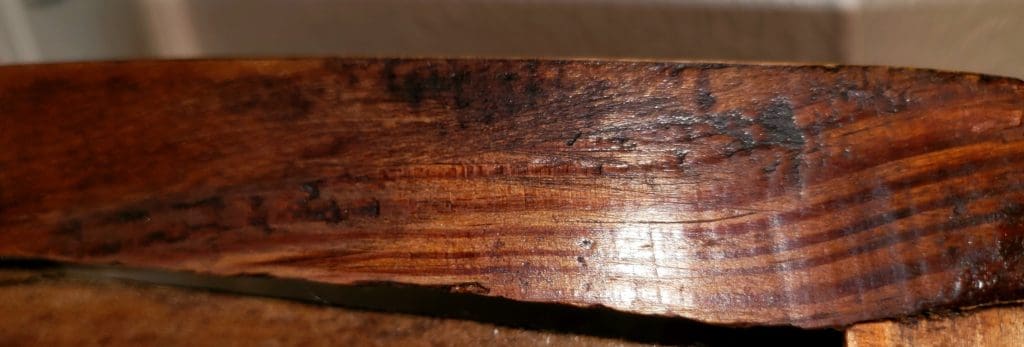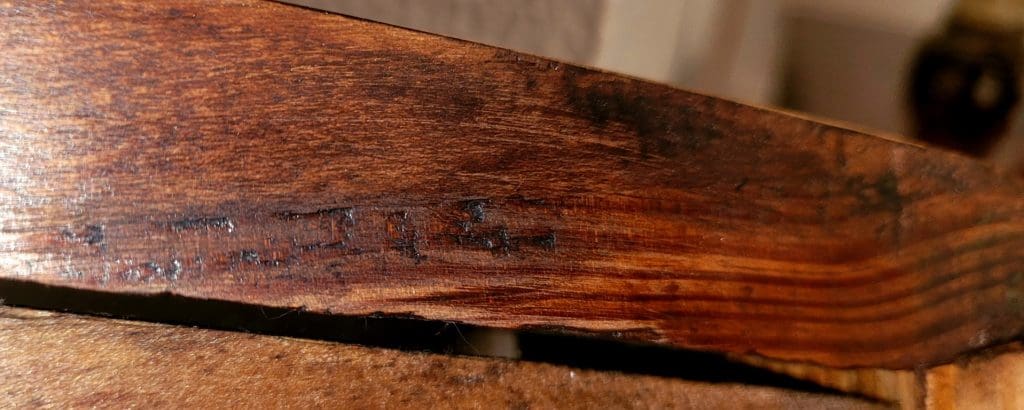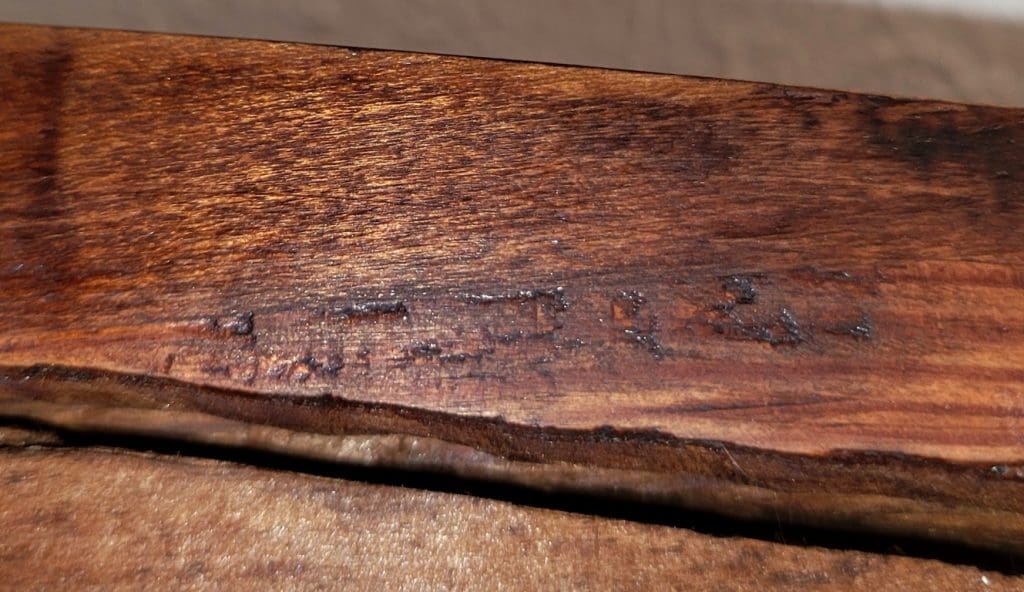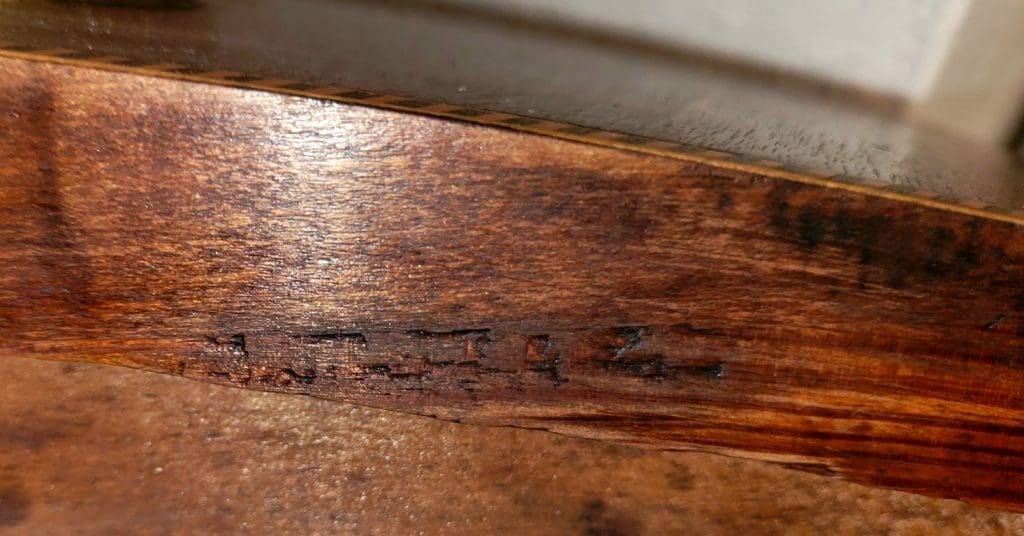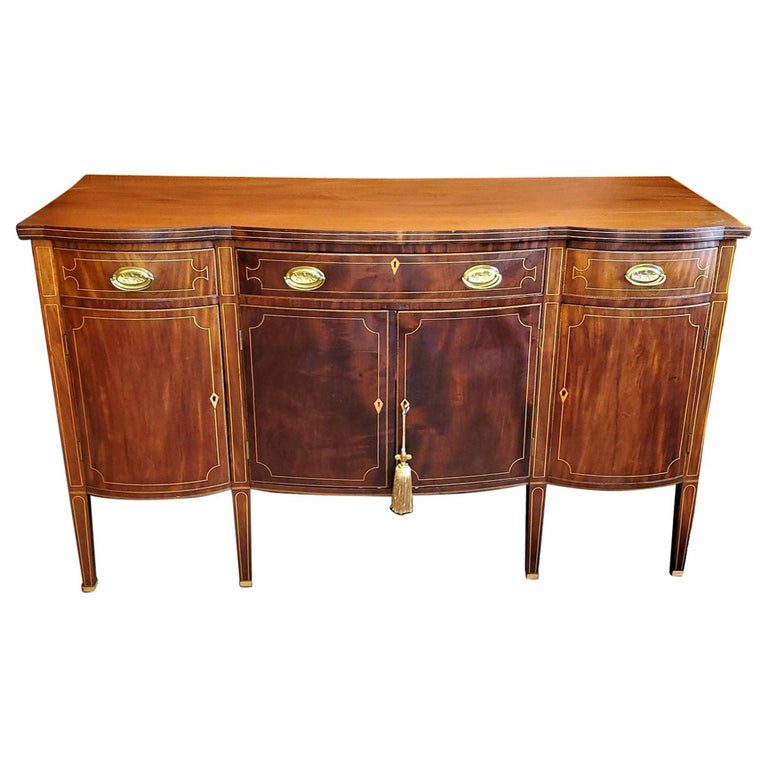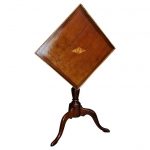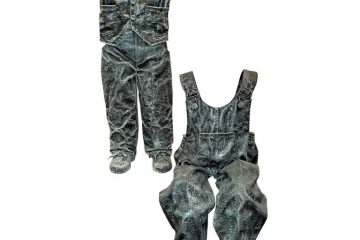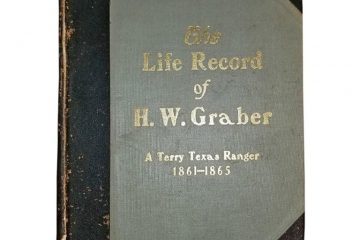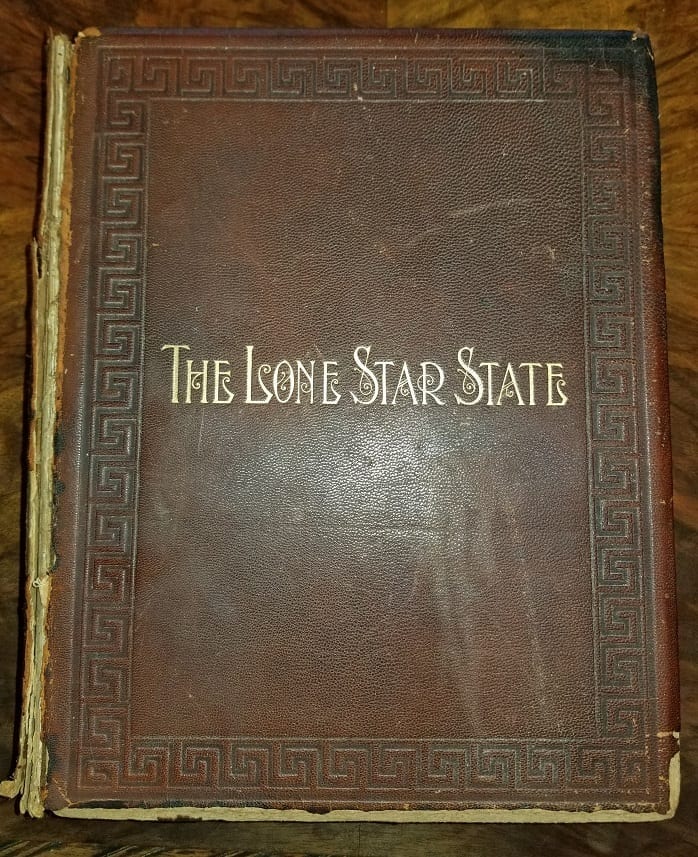Late 18C American Sheraton Sideboard by Duncan Phyfe – Important
We have the pleasure to present to you a STUNNING and IMPORTANT Late 18th century American Sheraton Sideboard, made circa 1788/89, in New York by the famous Duncan Phyfe.
Signed/Marked and dated on the base of the front of the middle drawer (See Pics).
We are confident that the bottom mark is – “DJ Fife & Co” – The “D”, “… Fe & Co” are clearly visible and above it to the right looks like a signature – ‘D Fife’ and ‘1788/9’.
On his 20th Birthday, Phyfe’s mother, gave him “The Cabinetmaker & Upholsterer’s Drawing Book in Four Parts 1788” by Thomas Sheridan. This had a profound impact on Phyfe’s understanding of the basic geometry, the purity of form and refinement of structural dimensions to cabinet making. Sheraton’s Book taught the young Scotsman to reject the florid and OTT ornament of the dying European Kings and adopt simpler lines.
In a few years he opened his own shop in Albany, NY and used Sheraton’s designs. The quality of this piece, is ‘classic’ Duncan (Fife) Phyfe during his early homage to Thomas Sheraton.
What makes this piece even MORE IMPORTANT is the date, which is either 1788 or 1789 which means that Phyfe was only 20 or 21 years of age when he made this and therefore it is one of his very EARLIEST pieces!!!
The quality of this piece, is ‘classic’ Duncan (Fife) Phyfe during his early homage to Thomas Sheraton.
It is of exceptional construction, craftsmanship and style to identify it as a piece of American Sheraton. The combination of woods and veneers tells us this also. The front is mahogany veneer with satinwood herringbone stringing and satinwood/tulipwood escutcheons. The secondary woods are walnut, cheery and birch.
This piece features finely case brass handles with a thistle motif, the national flower and emblem of Duncan Phyfe’s home country of Scotland.
It also has 2 swinging doors on either side which open to reveal shelving and the 2 central doors likewise.
The front is serpentine in shape and form with each door of a convex nature.
It sits on 8 fluted and graduating legs with the front 4 reflecting the satinwood stringing and banding of the upper portion.
We recently had some of the locks serviced (and keys made) by a professional locksmith who informed us that the locks were original Early American locks and he has rarely seen others like them. This again, helps us in authenticating the age of the piece!
THIS IS A GORGEOUS and ORIGINAL PIECE OF EARLY AMERICAN FURNITURE BY A FAMOUS MAKER
IT IS ALSO FROM A PERIOD WHERE PHYFE’S CAREER WAS JUST TAKING OFF IN NEW YORK AND IS MUCH MORE DESIRABLE THAN HIS LATER PIECES!
Duncan Phyfe (1768 – 16 August 1854) was one of nineteenth-century America’s leading cabinetmakers.
Although he did not create any new furniture style, he interpreted fashionable European trends in a manner so distinguished and particular that he became a major spokesman for Neoclassicism in the United States, influencing a whole generation of American cabinetmakers.
Born Duncan Fife near Loch Fannich, Scotland, he immigrated with his family to Albany, New York, in 1784 and served as a cabinetmaker’s apprentice.
In 1791 he moved to New York City and one year later is documented the earliest mention of him in the city, when he was elected to the General Society of Mechanics and Tradesmen, sponsored by Isaac Nichols and Seabury Champlin, either of whom may have trained him.
By the time of his marriage in 1793, he appears in the New York directories as a “joiner,” but by 1794 he called himself “cabinetmaker” and had changed the spelling of his name to Phyfe. He opened his own business in 1794 and was listed as a cabinetmaker in the New York Directory and Register. From his first shop on 2 Broad Street, he later moved to Partition Street (later renamed Fulton Street in 1817 in honor of Robert Fulton), where he stayed for the rest of his life.
A poor immigrant when he arrived in America from his native Scotland, Phyfe acquired wealth and fame through hard work, exceptional talent and the support of patrons. He would come to count among his clients some of the nation’s wealthiest and most storied families. Throughout the first half of the nineteenth century he made Neoclassical furniture for the social and mercantile elite of New York, Philadelphia, and the American South where he was particularly popular. Known during his lifetime as the “United States Rage”, to this day remains America’s best-known cabinetmaker. Establishing his reputation as a purveyor of luxury by designing high-quality furniture.
His personal style, characterized by superior proportions, balance, symmetry, and restraint, became the New York local style. Many apprentices and journeymen exposed to this distinctive style by serving a stint in the Phyfe shop or by copying the master cabinetmaker’s designs helped to create and sustain this local school of cabinetmaking. Demand for Phyfe’s work reached its peak between 1805 and 1820, although he remained a dominant figure in the trade until 1847, when he retired at the age of seventy-seven. Within the short span of a single generation, however, the work of the master was all but forgotten until the revival in the 1920s, when different furniture companies replicated his designs for several decades.
He became known as one of America’s leading cabinetmakers by selling furniture at relatively low prices. Phyfe’s work encompassed a broad range of the period’s Neoclassical styles, starting from his earliest furnitures— which bear the influence of his 18th-century British predecessors Thomas Sheraton and Thomas Hope— continuing with Regency, Federal, Empire and ending with his late simplified designs in the Grecian plain style.
James Duncan Phyfe =
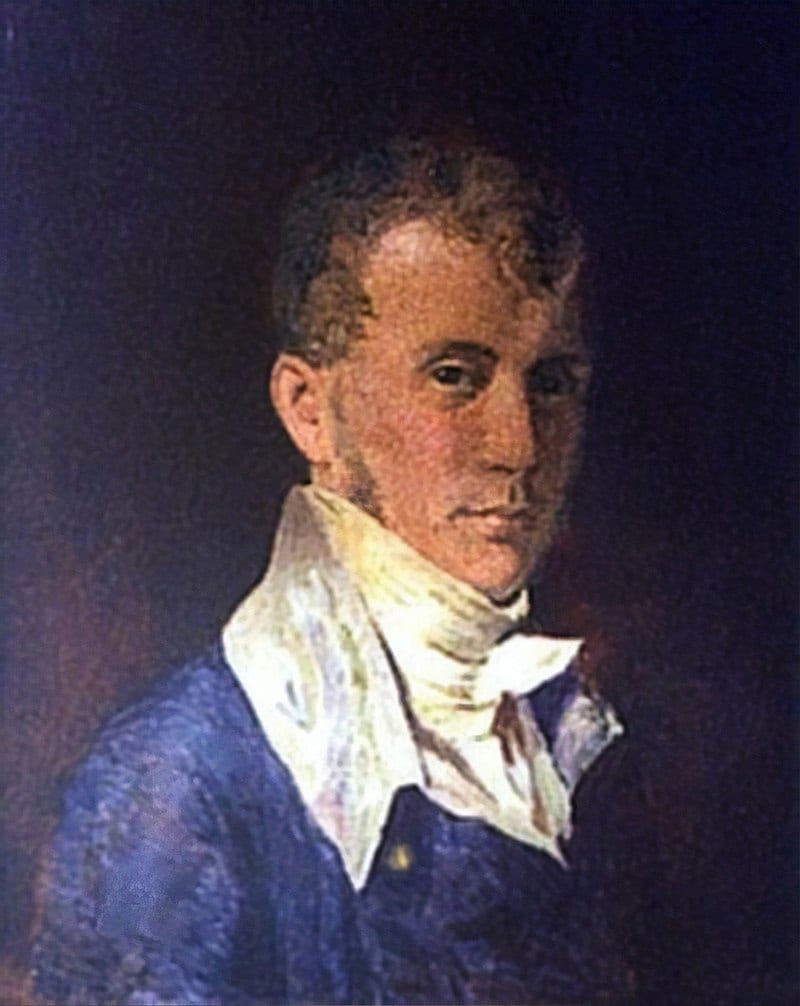

Between 1837 and 1847, Duncan Phyfe took his two sons, Michael and James, as business partners and the firm went under the names D. Phyfe & Sons (1837–1840) and after Michael’s premature death, D. Phyfe & Son (1840–1847). It was during the latter and final stages of the business’s history that perhaps the greatest challenge Phyfe ever faced emerged; how to cope with the new wave of historical revival styles. In 1840, one Southern planter who came to New York from Columbia, South Carolina, observed to his wife in a letter that the Phyfes were “as much behind the times in style as (they were) in price.” This is because the Phyfes always adhered to the classicist language until the end, they never fully engaged with the emerging historical revival styles (e.g. Baroque, Gothic, Rococo, etc.) that began in the 1830s.
Duncan Phyfe and his son James finally closed down the family business in 1847 after fifty-five years in the trade. They held an auction of the remaining contents of their furniture warehouse. The auctioneer was Halliday & Jenkins.
Because Phyfe’s furniture was seldom signed, yet widely imitated, it is sometimes difficult to determine with accuracy which works he actually made. He is interred at Green-Wood Cemetery in Brooklyn, New York.
On 15 October 1922, the Metropolitan Museum of Art opened to the public “Furniture from the Workshop of Duncan Phyfe”, the first exhibition ever held in an art museum on the work of a single cabinetmaker. Ninety years later and only for the second time in history, a major retrospective on this iconic American craftsman and his furniture was again on view from 20 December 2011 – 6 May 2012, under the title “Duncan Phyfe: Master Cabinetmaker in New York”.
Another exhibition took place at the Museum of Fine Arts, Houston from 24 June – 9 September 2012.
Duncan Phyfe’s furniture can be admired in the White House Green Room, Edgewater, Roper House and especially at Millford Plantation, owned by the Classical American Homes Preservation Trust. His furniture appears in many museums and private collections as well.
Link: https://en.wikipedia.org/wiki/Duncan_Phyfe




Late 18C American Sheraton Sideboard by Duncan Phyfe.
Provenance: From an Outstanding Dallas Private Collection.
Condition: Very good for it’s age. Some minor losses of veneer (chips) but nothing serious. 2 of the internal base shelves are replacements. Has a key for central lock but needs a key for 2 side locks. Crack on the top but does not detract from the piece. Same with the sides.
Dimensions: 68.75 inches wide, 41.2 inches tall and 24.25 inches deep.
SALE PRICE NOW: $40,000
